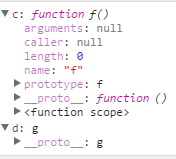談談我對JavaScript中typeof和instanceof的深入理解_javascript技巧
這次主要說說javascript的型別判斷函式typeof和判斷建構函式原型instanceof的用法和注意的地方。
typeof
先來說說typeof吧。首先要注意的是,typeof方法傳回一個字串,來表示資料的型別。
typeof 是一個一元運算,放在一個運算數之前,運算數可以是任意型別。
它傳回值是一個字串,該字串說明運算數的類型。 typeof 一般只能回傳以下幾個結果:
number,boolean,string,function,object,undefined。我們可以使用typeof 來取得一個變數是否存在,如if(typeof a!="undefined"){alert("ok")},而不要去使用if(a) 因為如果a 不存在(未宣告)則會出錯,對於Array,Null 等特殊物件使用typeof 一律傳回object,這正是typeof 的限制。
文法解說
我們先來看看各個資料型態對應typeof的值:
| 資料型別 | Type |
|---|---|
| Undefined | 「undefined」 |
| Null | 「object」 |
| 布林值 | 「boolean」 |
| 數值 | 「number」 |
| 字串 | 「string」 |
| Symbol (ECMAScript 6 新增) | 「symbol」 |
| Host object (provided by JS environment, such as browser) | Implementation-dependent |
| Function Object | "function" |
| Any other object | "object" |
Let’s look at specific examples:
// Numbers
typeof 37 === 'number';
typeof 3.14 === 'number';
typeof Math.LN2 === 'number';
typeof Infinity === 'number';
typeof NaN === 'number'; // 尽管NaN是"Not-A-Number"的缩写,意思是"不是一个数字"
typeof Number(1) === 'number'; // 不要这样使用!
// Strings
typeof "" === 'string';
typeof "bla" === 'string';
typeof (typeof 1) === 'string'; // typeof返回的肯定是一个字符串
typeof String("abc") === 'string'; // 不要这样使用!
// Booleans
typeof true === 'boolean';
typeof false === 'boolean';
typeof Boolean(true) === 'boolean'; // 不要这样使用!
// Symbols
typeof Symbol() === 'symbol';
typeof Symbol('foo') === 'symbol';
typeof Symbol.iterator === 'symbol';
// Undefined
typeof undefined === 'undefined';
typeof blabla === 'undefined'; // 一个未定义的变量,或者一个定义了却未赋初值的变量
// Objects
typeof {a:1} === 'object';
// 使用Array.isArray或者Object.prototype.toString.call方法可以从基本的对象中区分出数组类型
typeof [1, 2, 4] === 'object';
typeof new Date() === 'object';
// 下面的容易令人迷惑,不要这样使用!
typeof new Boolean(true) === 'object';
typeof new Number(1) ==== 'object';
typeof new String("abc") === 'object';
// 函数
typeof function(){} === 'function';
typeof Math.sin === 'function';We will find a problem, that is, typeof is not accurate to determine the data type. For example, the typeof return value of arrays, regular expressions, dates, and objects is all object, which will cause some errors.
So on the basis of typeof judging the type, we also need to use the Object.prototype.toString method to further judge the data type.
Let’s take a look at the difference between the return values of the toString method and the typeof method in the case of the same data type:
| 數據 | toString | 類型 |
|---|---|---|
| 「富」 | 字串 | 字串 |
| 新字串(“foo”) | 字串 | 對象 |
| 新數字(1.2) | 數字 | 對象 |
| 真實 | 布林值 | 布林值 |
| new Boolean(true) | Boolean | object |
| new Date() | Date | object |
| new Error() | Error | object |
| new Array(1, 2, 3) | Array | object |
| /abc/g | RegExp | object |
| new RegExp(“meow”) | RegExp | object |
可以看到利用toString方法可以正确区分出Array、Error、RegExp、Date等类型。
所以我们一般通过该方法来进行数据类型的验证
真题检测
但是既然今天说到了typeof,那这里就列出几道题目,来看看自己是否真正掌握了typeof的用法。
第一题:
var y = 1, x = y = typeof x; x;
第二题:
(function f(f){
return typeof f();
})(function(){ return 1; });第三题:
var foo = {
bar: function() { return this.baz; },
baz: 1
};
(function(){
return typeof arguments[0]();
})(foo.bar);第四题:
var foo = {
bar: function(){ return this.baz; },
baz: 1
}
typeof (f = foo.bar)();第五题:
var f = (function f(){ return "1"; }, function g(){ return 2; })();
typeof f;第六题:
var x = 1;
if (function f(){}) {
x += typeof f;
}
x;第七题:
(function(foo){
return typeof foo.bar;
})({ foo: { bar: 1 } });下面公布答案了,这七题的答案分别是:
"undefined","number","undefined","undefined","number","1undefined","undefined"
做对了几道呢?是不是很大的困惑呢?这几题虽然都有typeof,但是考察了很多javascript的基础噢。下面我们来一一详解。
第一题:
var y = 1, x = y = typeof x; x;//"undefined"
表达式是从右往左的,x由于变量提升,类型不是null,而是undefined,所以x=y=”undefined”。
变量提升我在这篇文章中提到过,可以看看。
第二题:
(function f(f){
return typeof f();//"number"
})(function(){ return 1; });传入的参数为f也就是function(){ return 1; }这个函数。通过f()执行后,得到结果1,所以typeof 1返回”number”。这道题很简单,主要是区分f和f()。
第三题:
var foo = {
bar: function() { return this.baz; },
baz: 1
};
(function(){
return typeof arguments[0]();//"undefined"
})(foo.bar);这一题考察的是this的指向。this永远指向函数执行时的上下文,而不是定义时的(ES6的箭头函数不算)。当arguments执行时,this已经指向了window对象。所以是”undefined”。对this执行不熟悉的同学可以看看这篇文章:深入理解this,对刚刚提到的箭头函数感兴趣的同学可以看看初步探究ES6之箭头函数。
第四题:
var foo = {
bar: function(){ return this.baz; },
baz: 1
}
typeof (f = foo.bar)();//undefined如果上面那一题做对了,那么这一题也应该不会错,同样是this的指向问题。
第五题:
var f = (function f(){ return "1"; }, function g(){ return 2; })();
typeof f;//"number"这一题比较容易错,因为我在遇到这道题之前也从来没有遇到过javascript的分组选择符。什么叫做分组选择符呢?举一个例子就会明白了:
var a = (1,2,3); document.write(a);//3,会以最后一个为准
所以上面的题目会返回2,typeof 2当然是”number”啦。
第六题:
var x = 1;
if (function f(){}) {
x += typeof f;
}
x;//"1undefined"这是一个javascript语言规范上的问题,在条件判断中加入函数声明。这个声明语句本身没有错,也会返回true,但是javascript引擎在搜索的时候却找不到该函数。所以结果为”1undefined”。
第七题:
(function(foo){
return typeof foo.bar;
})({ foo: { bar: 1 } });这题其实是一个考察心细程度的题目。形参的foo指向的是{ foo: { bar: 1 } }这个整体。相信这么说就明白了。
好啦。上面的题目都是很好的资源噢。
instanceof
接下来该说说instanceof方法了。instanceof运算符可以用来判断某个构造函数的prototype属性是否存在于另外一个要检测对象的原型链上。
instanceof 用于判断一个变量是否某个对象的实例,如 var a=new Array();alert(a instanceof Array); 会返回 true,同时 alert(a instanceof Object) 也会返回 true;这是因为 Array 是 object 的子类。再如:function test(){};var a=new test();alert(a instanceof test) 会返回
谈到 instanceof 我们要多插入一个问题,就是 function 的 arguments,我们大家也许都认为 arguments 是一个 Array,但如果使用 instaceof 去测试会发现 arguments 不是一个 Array 对象,尽管看起来很像。
如果对原型不太了解,可以看看深入理解原型。
下面我们看看instanceof的实例:
// 定义构造函数
function C(){}
function D(){}
var o = new C();
// true,因为 Object.getPrototypeOf(o) === C.prototype
o instanceof C;
// false,因为 D.prototype不在o的原型链上
o instanceof D;
o instanceof Object; // true,因为Object.prototype.isPrototypeOf(o)返回true
C.prototype instanceof Object // true,同上
C.prototype = {};
var o2 = new C();
o2 instanceof C; // true
o instanceof C; // false,C.prototype指向了一个空对象,这个空对象不在o的原型链上.
D.prototype = new C(); // 继承
var o3 = new D();
o3 instanceof D; // true
o3 instanceof C; // true但是这里我们需要注意一个问题:
function f(){ return f; }
document.write(new f() instanceof f);//false
function g(){}
document.write(new g() instanceof g);//true第一个为什么返回false呢?因为构造函数的原型被覆盖了,我们可以看看new f和new g的区别:


熱AI工具

Undresser.AI Undress
人工智慧驅動的應用程序,用於創建逼真的裸體照片

AI Clothes Remover
用於從照片中去除衣服的線上人工智慧工具。

Undress AI Tool
免費脫衣圖片

Clothoff.io
AI脫衣器

AI Hentai Generator
免費產生 AI 無盡。

熱門文章

熱工具

記事本++7.3.1
好用且免費的程式碼編輯器

SublimeText3漢化版
中文版,非常好用

禪工作室 13.0.1
強大的PHP整合開發環境

Dreamweaver CS6
視覺化網頁開發工具

SublimeText3 Mac版
神級程式碼編輯軟體(SublimeText3)

熱門話題
 在JavaScript中替換字符串字符
Mar 11, 2025 am 12:07 AM
在JavaScript中替換字符串字符
Mar 11, 2025 am 12:07 AM
JavaScript字符串替換方法詳解及常見問題解答 本文將探討兩種在JavaScript中替換字符串字符的方法:在JavaScript代碼內部替換和在網頁HTML內部替換。 在JavaScript代碼內部替換字符串 最直接的方法是使用replace()方法: str = str.replace("find","replace"); 該方法僅替換第一個匹配項。要替換所有匹配項,需使用正則表達式並添加全局標誌g: str = str.replace(/fi
 如何在瀏覽器中優化JavaScript代碼以進行性能?
Mar 18, 2025 pm 03:14 PM
如何在瀏覽器中優化JavaScript代碼以進行性能?
Mar 18, 2025 pm 03:14 PM
本文討論了在瀏覽器中優化JavaScript性能的策略,重點是減少執行時間並最大程度地減少對頁面負載速度的影響。
 jQuery矩陣效果
Mar 10, 2025 am 12:52 AM
jQuery矩陣效果
Mar 10, 2025 am 12:52 AM
將矩陣電影特效帶入你的網頁!這是一個基於著名電影《黑客帝國》的酷炫jQuery插件。該插件模擬了電影中經典的綠色字符特效,只需選擇一張圖片,插件就會將其轉換為充滿數字字符的矩陣風格畫面。快來試試吧,非常有趣! 工作原理 插件將圖片加載到畫布上,讀取像素和顏色值: data = ctx.getImageData(x, y, settings.grainSize, settings.grainSize).data 插件巧妙地讀取圖片的矩形區域,並利用jQuery計算每個區域的平均顏色。然後,使用
 如何使用瀏覽器開發人員工具有效調試JavaScript代碼?
Mar 18, 2025 pm 03:16 PM
如何使用瀏覽器開發人員工具有效調試JavaScript代碼?
Mar 18, 2025 pm 03:16 PM
本文討論了使用瀏覽器開發人員工具的有效JavaScript調試,專注於設置斷點,使用控制台和分析性能。
 如何構建簡單的jQuery滑塊
Mar 11, 2025 am 12:19 AM
如何構建簡單的jQuery滑塊
Mar 11, 2025 am 12:19 AM
本文將引導您使用jQuery庫創建一個簡單的圖片輪播。我們將使用bxSlider庫,它基於jQuery構建,並提供許多配置選項來設置輪播。 如今,圖片輪播已成為網站必備功能——一圖胜千言! 決定使用圖片輪播後,下一個問題是如何創建它。首先,您需要收集高質量、高分辨率的圖片。 接下來,您需要使用HTML和一些JavaScript代碼來創建圖片輪播。網絡上有很多庫可以幫助您以不同的方式創建輪播。我們將使用開源的bxSlider庫。 bxSlider庫支持響應式設計,因此使用此庫構建的輪播可以適應任何
 用JavaScript增強結構標記
Mar 10, 2025 am 12:18 AM
用JavaScript增強結構標記
Mar 10, 2025 am 12:18 AM
核心要点 利用 JavaScript 增强结构化标记可以显著提升网页内容的可访问性和可维护性,同时减小文件大小。 JavaScript 可有效地用于为 HTML 元素动态添加功能,例如使用 cite 属性自动在块引用中插入引用链接。 将 JavaScript 与结构化标记集成,可以创建动态用户界面,例如无需页面刷新的选项卡面板。 确保 JavaScript 增强功能不会妨碍网页的基本功能至关重要;即使禁用 JavaScript,页面也应保持功能正常。 可以使用高级 JavaScript 技术(
 如何使用Angular上傳和下載CSV文件
Mar 10, 2025 am 01:01 AM
如何使用Angular上傳和下載CSV文件
Mar 10, 2025 am 01:01 AM
數據集對於構建API模型和各種業務流程至關重要。這就是為什麼導入和導出CSV是經常需要的功能。在本教程中,您將學習如何在Angular中下載和導入CSV文件







